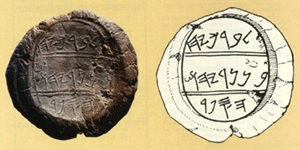
Literally hundreds of Hebrew seals and seal impressions have been discovered in the last century and a half either in authorized archaeological excavations or by clandestine diggers; the results of the latter ending up in the hands of antiquities dealers, subsequently to come into the hands of collectors or of scholars. Hardened clay seal impressions are called "bullae" (sg., bulla). Bullae have survived in damp earth in a remarkable way.
In biblical Israel, papyrus was the primary form of writing material. Once an official document was written, it would be rolled up, one end folded in one-third of the breadth and the opposite end similarly folded in. The document, now shortened by folding, was tied with a string and a lump of clay was impressed on the knotted string. Then the upper surface of the clay lump was impressed with the signet ring of the owner of the document or its writer. Such documents were stored in temple or palace archives, with the unbroken seal guaranteeing the validity of the document's contents.
The reason the clay bullae survived is that a conflagration that destroyed the building and the papyrus archive fired the clay sealings, making them practically indestructible. The evidence of the knotted cord to which the clay had been attached remains on the underside of the bullae.
Sometime during the 1970's, a bulla containing the stamp and name of the scribe of Jeremiah appeared on the antiquities market and was acquired by a collector, Dr. R. Hecht. He permitted Israeli archaeologist Nahman Avigad to publish the bulla, which came from an unidentified place, now thought to be the "burnt house" excavated by Yigal Shiloh. The bulla is now in the Israel Museum. It measures 17 by 16 mm, and is stamped with an oval seal, 13 by 11 mm. A single line borders the impression, and it is divided by double horizontal lines into three registers bearing the following inscription:
The script used is the pre-exilic ancient Hebrew linear script, rather than the post-exilic script adopted by Jews from the contemporary Aramaic script. Reading the Hebrew from right to left, the first letter, Heb (l), is the preposition "to, belonging to," and the last three letters, heb. (yhw)is a shortened form of the name of God, Heb. (yhwh), the shortened form was likely pronounced "yahu." Baruch's name means "Blessed of the Lord (Yahweh)."
This bulla was without doubt from the impression of Baruch ben Neriah , the scribe who wrote to the dictation of the prophet Jeremiah (Jer 36:4). Dr. Avigad expressed his personal feelings as he worked with the Baruch Bulla as having the feeling "of personal contact with persons who figure prominently in the dramatic events in which the giant figure of Jeremiah and his faithful follower Baruch were involved at a most critical time preceding the downfall of Judah."
Avigad also published a seal bearing the inscription "Belonging to Seraiah (ben) Neriah." Seriah was the "chief chamberlain" in the court of King Zedekiah (Jer 51:59). [12] He accompanied the king to Babylon, and he carried a written oracle from the prophet Jeremiah looking for the ultimate destruction of Babylon, which he was to read aloud on his arrival in the city, then to throw the document into the Euphrates (Jer 59:64). Seriah ben Neriah was the brother of Baruch ben Neriah, and both were close friends of the prophet Jeremiah.
For more interesting topics related to archaeology, visit archaeology excavations.
No comments:
Post a Comment